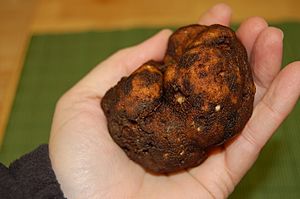Oregon brown truffle facts for kids
Quick facts for kids Oregon brown truffle |
|
|---|---|
 |
|
| Scientific classification |
The Kalapuya brunnea is a special type of truffle. It's the only known species in its fungal genus called Kalapuya. You can only find this truffle in the Pacific Northwest part of the United States. This includes western Oregon and northern California.
People in the area often call it the Oregon brown truffle. For a while, scientists thought it was a new kind of Leucangium truffle. But then, they used special tests on its DNA (molecular analysis). These tests showed it was different enough to be its own unique genus.
The Oregon brown truffle is reddish-brown. Its outer skin, called the peridium, feels rough and warty. Inside, the part that makes spores, called the gleba, starts out whitish. As it gets older, it turns a grayish-brown color with spots. When the truffles are fully grown, they smell a bit like garlicky cheese. This smell is similar to mature Camembert cheese. People in Oregon have collected and eaten this truffle because it's good for cooking.
Contents
Discovering the Oregon Brown Truffle
Scientists officially described this species in 2010. They found the first samples in February 2009 in Benton County, Oregon. Before this, local people had known about the Oregon brown truffle for several years. They thought it was an unknown type of Leucangium. This was because it looked similar to the Oregon black truffle, Leucangium carthusianum, and grew in the same places. They even gave it a temporary name: Leucangium brunneum.
How Scientists Identified It
Scientists used advanced DNA tests to study the truffle. These tests showed that Kalapuya brunnea is not related to other well-known truffle groups like Tuber. Instead, it is closely related to other fungi that grow underground. These include Fischerula, Imaia, and Leucangium.
Even though it's related to these, Kalapuya has unique features. Both its DNA and its physical traits (like its shape) are different enough. This is why scientists decided it needed its own new genus. The fungi in this group, including Kalapuya, all produce very large spores.
Naming the Truffle
The name Kalapuya comes from the Kalapuya people. They are a Native American group. Their traditional lands covered the area where this fungus grows. However, it's important to know that the Kalapuya people are not known to have eaten this truffle. Some Native American groups consider certain mushrooms to be taboo food.
The second part of the name, brunnea, is Latin. It means "brown." This refers to the color of the mature truffle.
What the Oregon Brown Truffle Looks Like
The fruit bodies of Kalapuya are like small, round truffles. They often have bumps and grooves. They usually measure about 12 to 60 millimeters (about 0.5 to 2.4 inches) wide. They are about 10 to 45 millimeters (about 0.4 to 1.8 inches) tall.
The outer skin, or peridium, can be up to 2 millimeters thick. Its color can be light yellowish-brown, orange-brown, or reddish-brown. Older truffles often have darker patches. The surface feels rough because it's covered with flat or rounded bumps. These bumps are about 0.5 to 3 millimeters wide. Sometimes, bigger bumps even have smaller bumps on them. As the truffle gets older, small cracks can appear on its surface.
The inside part of the truffle, called the gleba, is where the spores are made. When it's young, the gleba is whitish and firm. But as the truffle matures, it develops grayish-brown spots.
Is it Edible?
Yes, the Oregon brown truffle is edible! People have collected it for cooking. However, it's not as commonly harvested as some other truffles from the Pacific Northwest. Both the taste and smell of this truffle are like mature Camembert cheese. One person said it tasted like "buttered lobster" when served with melted butter on sliced bread.
Where it Grows
This truffle is only found in the Pacific Northwest of the United States. It grows in forests with Douglas fir trees. These forests are usually up to about 50 years old. Scientists believe the truffle needs these specific trees to grow. This is called a symbiotic relationship.
You can usually find the truffles from October through March. They grow in the top 2 to 10 centimeters (about 0.8 to 4 inches) of soil. They are often hidden under fallen leaves and other plant material. They can be found from sea level up to about 500 meters (about 1,640 feet) high. You can find them on the west side of Oregon's Cascade Range. They also grow in the Coastal Ranges of Oregon and northern California.
Similar Species
The Leucangium carthusianum, also known as the Oregon black truffle, looks somewhat similar. It also grows in similar places and during the same time of year. However, you can tell them apart because the Oregon black truffle has a much darker, charcoal-black outer skin. The Oregon black truffle is also edible and is valued for its taste and smell.
Images for kids
See also
 In Spanish: Kalapuya para niños
In Spanish: Kalapuya para niños


